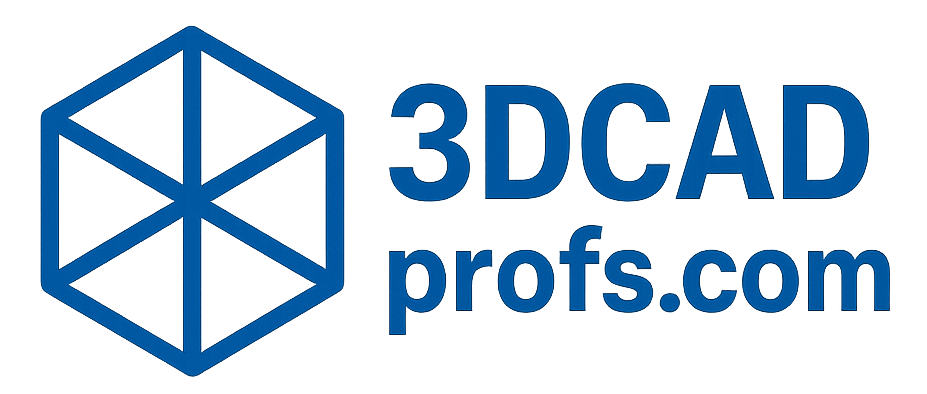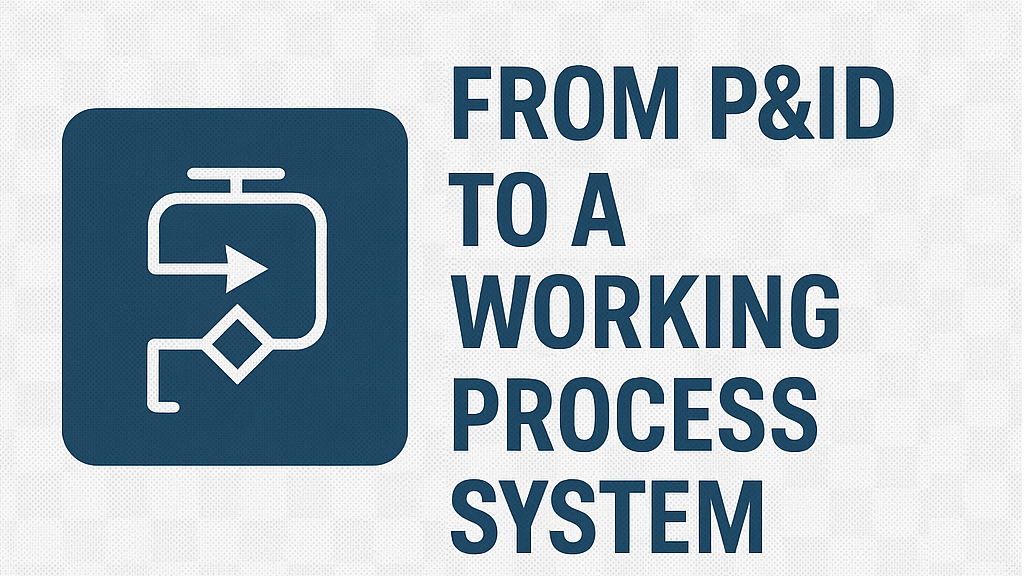From P&ID to a Working Process System
The Expanded Journey: Blueprint to Operation
The P&ID: Foundation for a Complex Journey
A Piping and Instrumentation Diagram (P&ID) serves as the critical blueprint for any process system, detailing all piping, equipment, and instrumentation. However, transforming this schematic into a safe, efficient, and fully operational process system is an extensive, multi-stage endeavor. This expanded guide delves deeper into the specific activities, roles, challenges, documentation, safety & quality aspects, and technologies involved in each phase after P&ID finalization.
The P&ID is the starting point. Below, we explore the comprehensive journey that follows.
The Transformation Phases: An In-Depth Look
Each phase is crucial, demanding specialized expertise and meticulous coordination.
Phase 1: Detailed Design & Engineering
This phase translates the conceptual P&ID into concrete, buildable engineering specifications and designs.
- Finalize process flow diagrams (PFDs) and heat & mass balances.
- Develop detailed equipment specifications and datasheets (vessels, pumps, exchangers, etc.).
- Perform detailed piping design: 3D modeling, isometric drawings, stress analysis, material selection.
- Design instrumentation & control systems: Finalize control philosophy, develop SAMA diagrams/logic diagrams, I/O lists, instrument datasheets, control panel layouts.
- Design electrical systems: Load calculations, single-line diagrams (SLDs), cable schedules, grounding, lighting design.
- Develop civil/structural designs: Foundation plans, structural steel details, pipe rack design.
- Conduct detailed Process Hazard Analysis (PHA) like HAZOP, LOPA studies.
- Perform Safety Integrity Level (SIL) assessment and verification for safety instrumented functions (SIFs).
- Prepare cause & effect diagrams.
- Develop 3D plant models integrating all disciplines.
- Process Eng.: Process simulations, PFDs, H&MB, P&ID updates, control philosophy, safety calculations.
- Mechanical Eng.: Equipment design/selection, datasheets, stress analysis for static/rotating equipment.
- Piping Eng.: Piping layouts, isometrics, stress analysis, material specifications, support design.
- Instrumentation & Control Eng.: Instrument selection, control system architecture (DCS/PLC/SIS), logic diagrams, loop diagrams.
- Electrical Eng.: Power system design, load flow/short circuit studies, hazardous area classification.
- Civil/Structural Eng.: Site layout, foundation design, structural analysis, building design.
- Safety Eng.: Facilitate HAZOP/LOPA, ensure compliance with safety standards.
- Scope creep and managing changes from the initial P&ID.
- Interdisciplinary clashes and coordination in the 3D model.
- Ensuring accurate vendor data for equipment.
- Meeting tight project schedules and budgets.
- Complexities in integrating new technologies.
- Approved for Construction (AFC) P&IDs.
- Detailed Equipment Datasheets & Specifications.
- Piping Isometrics, Layouts, Bill of Materials (BOMs).
- Instrument Index, Loop Diagrams, Control Narratives.
- Electrical SLDs, Cable Schedules, Hazardous Area Classification Drawings.
- Civil/Structural Drawings & Calculations.
- HAZOP/LOPA/SIL Reports.
- 3D Model Reviews & Clash Reports.
- Incorporating “Safety by Design” principles.
- Formal design reviews and verifications.
- Adherence to relevant codes and standards (ASME, API, IEC, etc.).
- Quality checks on all engineering deliverables.
- Process Simulation: Aspen HYSYS, UniSim.
- CAD/3D Modeling: AutoCAD Plant 3D, AVEVA E3D, Intergraph Smart 3D, SolidWorks.
- Piping Stress: CAESAR II, AutoPIPE.
- Instrumentation: SmartPlant Instrumentation (INtools), AVEVA Instrumentation.
- Electrical: ETAP, SKM PowerTools.
- Safety Analysis: PHA-Pro, exSILentia.
Phase 2: Procurement & Fabrication
Sourcing and acquiring all specified materials and equipment, and pre-fabricating components where feasible.
- Issue Request for Quotations (RFQs) to approved vendors.
- Technical and commercial bid evaluations.
- Award Purchase Orders (POs).
- Vendor drawing review and approval cycle.
- Expediting and tracking of equipment/material deliveries.
- Shop fabrication of piping spools, structural steel, and modular units.
- Factory Acceptance Tests (FAT) for critical equipment.
- Logistics planning for site delivery.
- Procurement Team: Manages RFQ, bidding, PO placement, logistics.
- Engineering Disciplines: Technical bid evaluation, vendor drawing review.
- Quality Assurance (QA): Vendor audits, inspection of fabricated items.
- Expediting Team: Monitors vendor progress and delivery schedules.
- Long lead times for specialized equipment.
- Managing multiple vendors and contracts.
- Ensuring vendor compliance with specifications.
- Transportation and customs clearance issues.
- Fluctuations in material prices.
- Approved Vendor List.
- Purchase Orders & Contracts.
- Approved Vendor Drawings & Data.
- Material Test Certificates (MTCs).
- FAT Reports.
- Shipping Documents & Delivery Schedules.
- Fabrication Drawings & Weld Maps.
- Quality control during fabrication (welding inspections, NDT).
- Ensuring materials meet specified standards.
- Safe handling and transportation of materials/equipment.
- Witnessing FATs to verify equipment performance.
- ERP Systems (e.g., SAP, Oracle) for procurement management.
- Supply Chain Management (SCM) software.
- Document Control Systems.
- CAD software for reviewing fabrication drawings.
Phase 3: Construction & Installation
The physical erection and assembly of the plant on site according to engineered designs.
- Site mobilization and setup of temporary facilities.
- Execution of civil works: foundations, trenches, sumps.
- Heavy lifting and installation of major equipment (columns, vessels, compressors).
- Erection of structural steel and pipe racks.
- Piping installation, field welding, bolt torqueing, and support installation.
- Installation of electrical equipment: transformers, switchgear, MCCs, cable trays, cable pulling and termination.
- Installation of instruments: transmitters, control valves, analyzers, junction boxes, tubing.
- Insulation of pipes and equipment, and final painting.
- Waste management and environmental controls.
- Construction Management: Overall site management, scheduling, contractor coordination.
- Field Engineers (All Disciplines): Provide technical support, resolve site queries, interpret drawings.
- Skilled Trades: Welders, pipefitters, electricians, millwrights, insulators.
- HSE (Health, Safety, Environment) Team: Ensure safe work practices, environmental compliance.
- QA/QC Team: Conduct inspections, verify compliance with specifications and standards.
- Managing site logistics and material laydown areas.
- Weather delays and adverse site conditions.
- Labor availability and productivity.
- Managing interfaces between multiple contractors.
- Late design changes impacting construction.
- Ensuring worker safety and incident prevention.
- Construction Work Packages.
- Permit to Work system.
- Daily/Weekly Progress Reports.
- Inspection and Test Plans (ITPs) & Records.
- Non-Conformance Reports (NCRs).
- Red-line mark-ups of drawings for “as-builting”.
- Safety records and incident reports.
- Rigorous site safety inductions and toolbox talks.
- Implementation of Job Safety Analyses (JSAs).
- Strict adherence to construction codes and quality standards.
- Welder qualification and NDT of welds.
- Material traceability and verification.
- Construction Management Software (e.g., Procore, Autodesk Build).
- Project Scheduling Software (Primavera P6, MS Project).
- 3D Model Viewers for field reference.
- Digital Inspection Tools.
Phase 4: Pre-Commissioning & Commissioning
Systematically verifying that all components and systems are installed correctly and function as designed before introducing hydrocarbons or process fluids.
- Pre-commissioning: System cleaning (flushing, air blowing, chemical cleaning), pressure testing (hydrostatic, pneumatic), instrument loop checks, point-to-point wiring checks, motor solo runs, alignment checks, leak testing.
- Commissioning: Functional testing of individual equipment and systems, control system logic verification (DCS/PLC), interlock and emergency shutdown (ESD) system testing, introduction of utilities (steam, nitrogen, instrument air, cooling water), initial catalyst loading (if applicable).
- First fills, inert gas purging, and then gradual introduction of process fluids.
- Performance testing to verify capacity and efficiency against design.
- Punch list generation and clearance.
- Commissioning Team: Leads and executes all commissioning activities. Often includes specialists from various disciplines.
- Operations Team: Increasingly involved to gain familiarity and participate in tests.
- Vendor Representatives: For specialized equipment commissioning.
- Engineering Support: To troubleshoot issues arising during testing.
- Dealing with incomplete construction or outstanding punch items.
- Unexpected equipment malfunctions or instrument errors.
- Control system logic issues or software bugs.
- Coordinating multiple activities and teams under tight schedules.
- Managing safety during live system testing.
- Pre-commissioning & Commissioning Procedures.
- Mechanical Completion Certificates.
- Loop Test Records, Calibration Certificates.
- Pressure Test Packages & Certificates.
- System Handover Certificates (from Construction to Commissioning, and Commissioning to Operations).
- Performance Test Reports.
- Cleared Punch Lists.
- Pre-Startup Safety Review (PSSR) report.
- Stringent adherence to Lock-Out Tag-Out (LOTO) procedures.
- Detailed risk assessments for all commissioning activities.
- Verification of all safety critical devices and systems.
- Ensuring all systems are clean and leak-free before introducing process fluids.
- Completion of the PSSR before final startup.
- Commissioning Management Software (CMS).
- Digital Punch List Management Tools.
- DCS/PLC Engineering & Diagnostic Tools.
- Specialized testing equipment (e.g., pressure recorders, loop calibrators).
Phase 5: Handover & Operation
The formal transfer of the completed and commissioned system to the end-user/operations team, followed by routine operation and maintenance.
- Final acceptance testing and performance validation by the owner/operator.
- Compilation and handover of the final project documentation package (including as-built P&IDs, drawings, vendor manuals, operating procedures, maintenance manuals, spare parts lists).
- Comprehensive training for operations and maintenance personnel.
- Transition to routine plant operation according to established procedures.
- Implementation of preventative and corrective maintenance programs.
- Ongoing performance monitoring, optimization, and troubleshooting.
- Management of Change (MOC) for any future modifications to the system.
- Demobilization of project and construction teams.
- Operations Team: Assumes responsibility for safe and efficient plant operation.
- Maintenance Team: Implements preventative and corrective maintenance.
- Project Team/EPC Contractor: Completes handover, provides warranty support, closes out project.
- Process/Plant Engineers: Monitor performance, identify optimization opportunities.
- Ensuring complete and accurate documentation handover.
- Adequacy of operator training and skill transfer.
- Early life equipment failures or “teething” problems.
- Optimizing plant performance to meet design targets.
- Establishing effective maintenance routines.
- Final As-Built Documentation (P&IDs, drawings, models).
- Operating Manuals & Procedures.
- Maintenance Manuals & Schedules.
- Spare Parts Interchangeability Records (SPIR).
- Training Records.
- Project Close-out Report.
- Performance Guarantee Certificates.
- Continuous adherence to safe operating procedures.
- Regular safety audits and reviews during operation.
- Implementation of MOC procedures to manage changes safely.
- Quality control in maintenance activities.
- Emergency preparedness and response plans.
- Distributed Control Systems (DCS) / SCADA systems for plant operation.
- Computerized Maintenance Management Systems (CMMS).
- Asset Performance Management (APM) software.
- Process Historians (e.g., OSIsoft PI System).
- Advanced Process Control (APC) software.
Key Disciplines Involved (Summary)
Successfully moving from P&ID to operation requires the coordinated effort of numerous engineering and technical disciplines. This chart shows an illustrative involvement level across the project lifecycle (details within each phase).
Note: Involvement levels are illustrative and vary greatly by project phase and complexity.
From Blueprint to Reality: A Complex, Collaborative Endeavor
The journey from a P&ID to a fully functional process system is an intricate and demanding process, underscoring the power of collaborative engineering, meticulous planning, and skilled execution. Each phase, from detailed design to ongoing operation, builds upon the last, requiring seamless integration of diverse expertise. Safety, quality, and adherence to standards are paramount throughout this lifecycle to ensure the final system is not only efficient and reliable but also safe for personnel and the environment. The P&ID remains the guiding document, but its successful realization depends on the dedication and competence of all teams involved.

